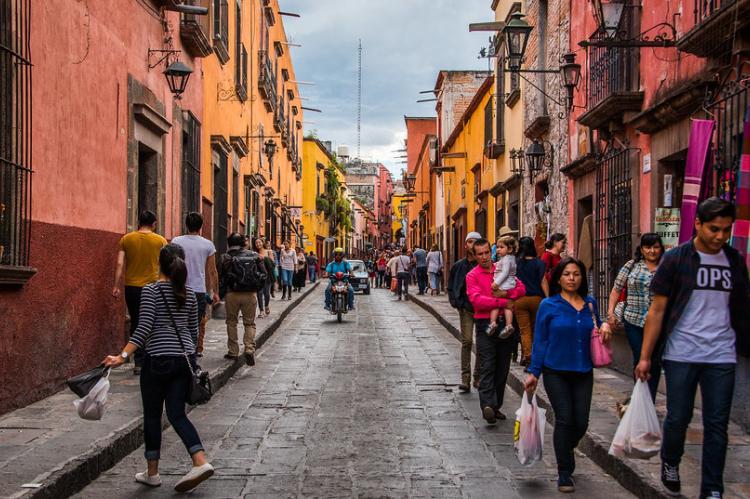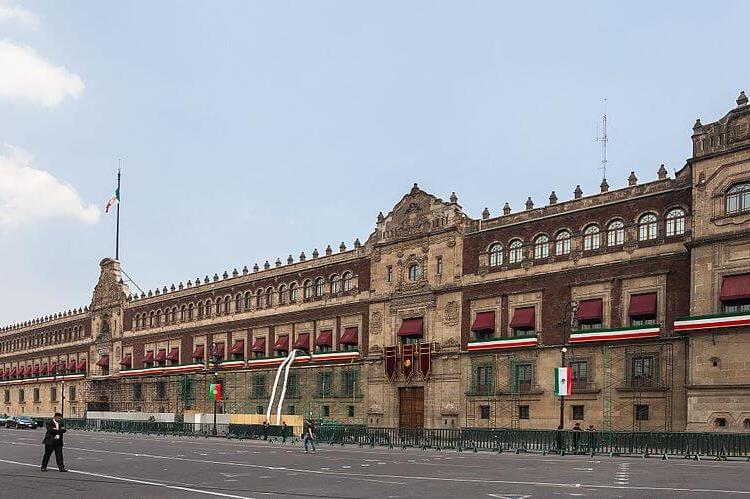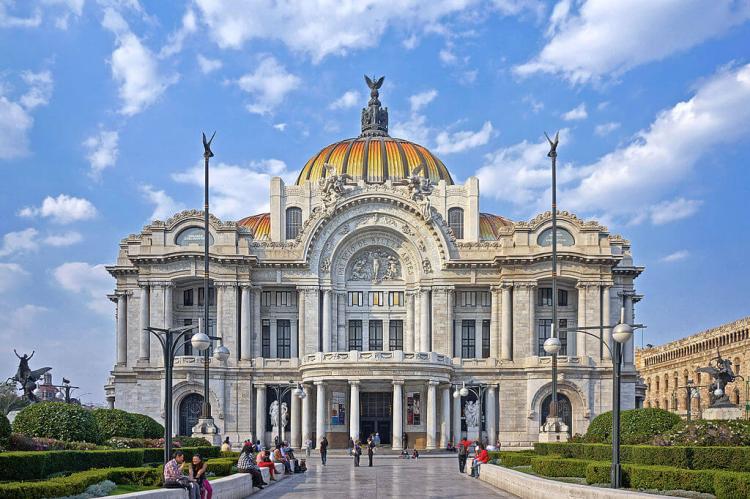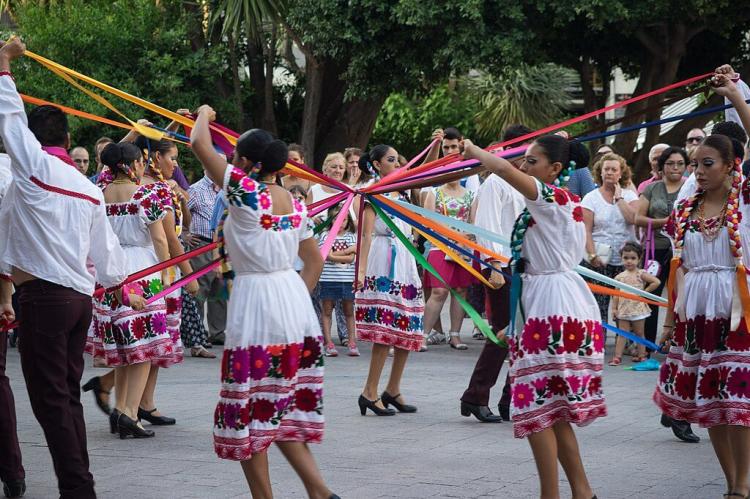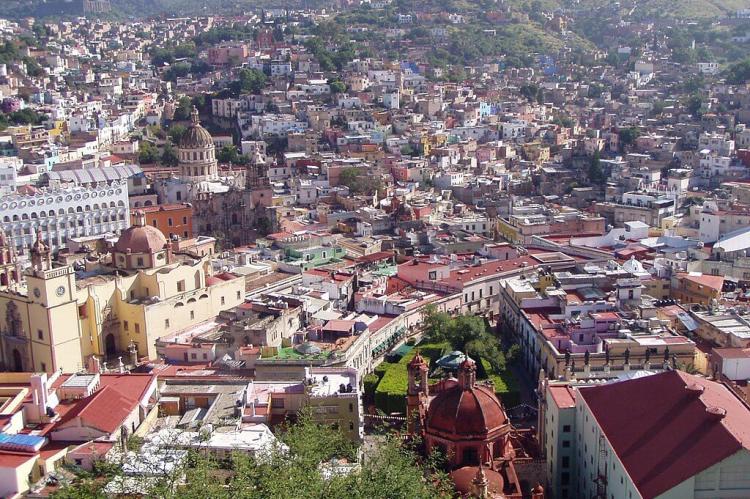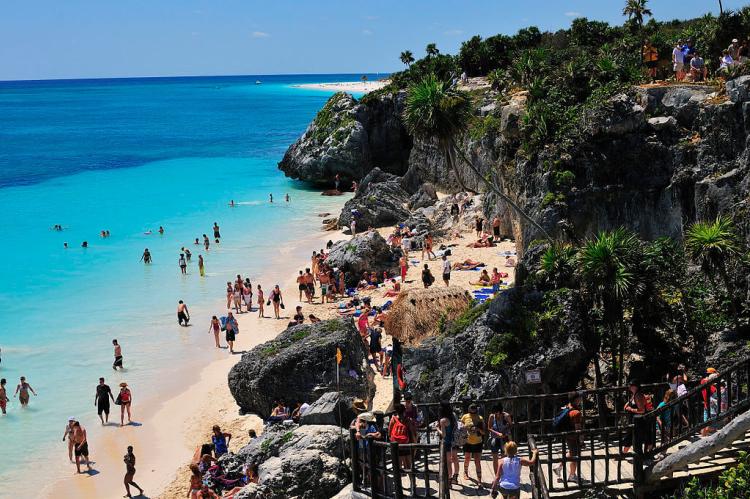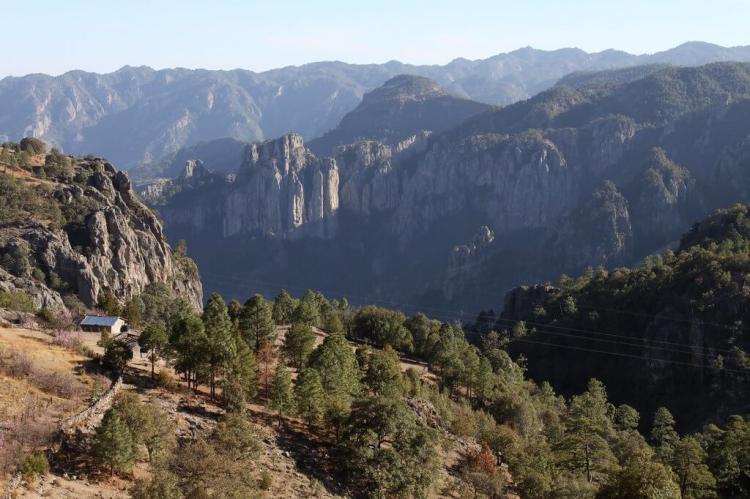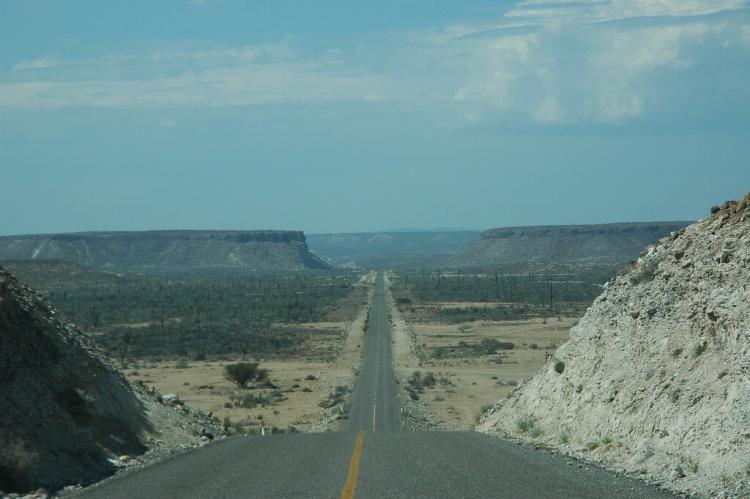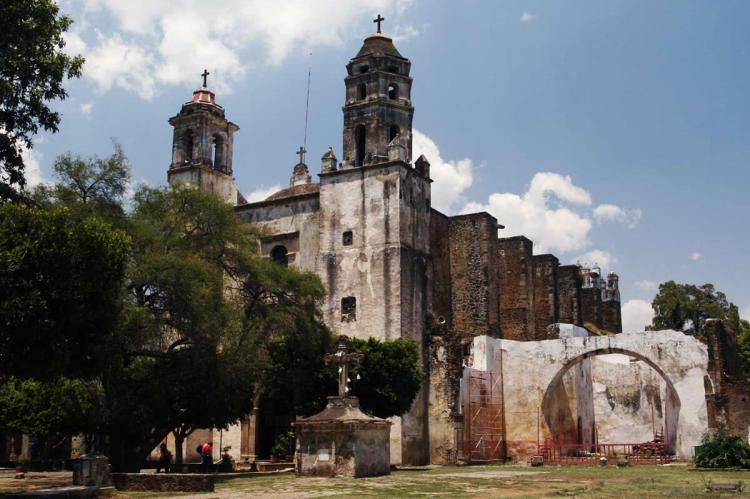Mexico: Cultural Landscape
Mexico has a rich culture originating from its deep indigenous heritage, the fusion of Spanish colonial customs, and the varied influences from around the world. This unique blend creates a vibrant mix of traditions, arts, music, cuisine, and festivals, resulting in a cultural story that is lively and significant.
The Cultural Landscape of Mexico
Mexico boasts a cultural richness that stems from its deep indigenous roots, the interweaving of Spanish colonial legacies, and the diverse influences from around the globe. This extraordinary amalgamation gives rise to a vivid array of traditions, arts, music, cuisine, and celebrations, forming a cultural narrative that is both dynamic and profound.
-
Indigenous Heritage: Mexico has numerous indigenous communities with distinct traditions, languages, and artistic expressions. These communities, such as the Maya, Aztecs, Zapotec, and Mixtec, contribute significantly to Mexico's cultural fabric through their art, music, cuisine, and religious practices.
-
Colonial Influence: Mexico's colonial past under Spanish rule has left an indelible mark on its culture. Architecture is a prime example, with colonial-era buildings in cities like Mexico City, Guadalajara, and Puebla. The fusion of Spanish and indigenous elements is evident in colonial art, cuisine, and religious customs, seen in the ornate baroque churches and religious processions.
-
Arts and Literature: Mexico has a vibrant arts scene, producing world-renowned painters like Frida Kahlo and Diego Rivera, who played significant roles in the 20th-century art movement. Literature also flourishes in Mexico, with authors such as Octavio Paz, Juan Rulfo, and Carlos Fuentes gaining international recognition for their works.
-
Folklore and Traditions: Mexico is renowned for its colorful folklore and traditions. Celebrations like Dia de los Muertos (Day of the Dead) exemplify the blending of indigenous beliefs with Catholicism, as families honor deceased loved ones with vibrant altars, marigold decorations, and visits to cemeteries. Traditional dances like the Jarabe Tapatío (Mexican Hat Dance) showcase Mexico's rich folkloric heritage.
-
Gastronomy: UNESCO globally celebrated and recognized Mexican cuisine as an Intangible Cultural Heritage of Humanity. From tacos, tamales, and mole to guacamole and chiles en nogada, Mexican food reflects a fusion of indigenous ingredients, Spanish influences, and regional variations. Each state in Mexico has its culinary specialties, contributing to the country's gastronomic diversity.
-
Music and Dance: Mexico's musical traditions are incredibly diverse, encompassing genres like mariachi, ranchera, cumbia, norteño, and banda music. Traditional instruments like the guitar, violin, trumpet, and accordion are commonly used. Dance forms like the lively Jarana Yucateca, graceful Folklorico, and the energetic danzón are widespread nationwide.
-
Handicrafts: Mexico is renowned for its exquisite handicrafts produced by skilled artisans. Talavera pottery from Puebla, embroidered textiles from Oaxaca, silver jewelry from Taxco, colorful Alebrijes sculptures from Oaxaca, and intricate Huichol beadwork are just a few examples of the diverse and visually stunning crafts found in Mexico.
Contemporary Influences on Mexican Culture
Mexican culture is a vibrant mix of indigenous, Spanish, and European influences. In recent years, Mexican culture has been influenced by several contemporary factors, including:
-
Globalization: Mexico is increasingly connected to the global economy and culture. This has led to the introduction of new technologies, ideas, and trends into Mexican society.
-
Immigration: Mexico has a large immigrant population, which has brought new cultures and perspectives to the country.
-
Tourism: Mexico is a popular tourist destination, which has exposed Mexicans to new cultures and ways of life.
These contemporary influences have had a significant impact on Mexican culture. They have led to a more diverse and cosmopolitan society and challenged traditional Mexican values and beliefs.
Challenges Facing Mexican Culture
Mexican culture faces several challenges, including:
-
Poverty: Mexico is a developing country and a significant problem. This has led to high crime, violence, and social unrest.
-
Inequality: Mexico is an unequal society. The gap between the rich and the poor is vast, leading to much social tension.
-
Corruption: Corruption is a significant problem in Mexico. This has eroded public trust in government and institutions and has made it difficult to address the country's other challenges.
These challenges threaten to undermine Mexican culture and society. However, Mexicans are resilient and have a long history of overcoming adversity. Mexican culture will likely continue to evolve and adapt in the face of these challenges.
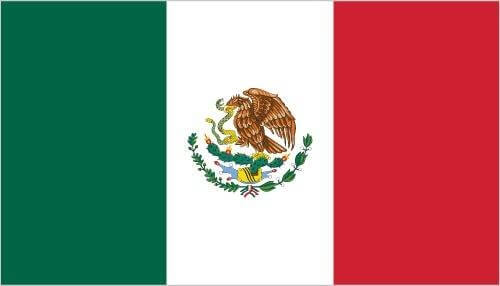
The official flag of Mexico
Cultural Geography of Mexico
Largest Cities / Metro Areas
Ranked by population estimate (2023):
-
Mexico City (9,210,000 / 21,919,000): Mexico City is the capital of Mexico, the most populous city in North America, and one of the most populated cities in the world. It is located in the Valley of Mexico at an altitude of 2,240 m (7,350 ft). The metro area has over 21 million people, making Mexico City a significant cultural, commerce, and finance center. It is home to many world-renowned universities, museums, and cultural institutions. The city is also a popular tourist destination for its historical landmarks, vibrant culture, and delicious food.
-
Tijuana (1,922,000 / 2,537,000): Tijuana is a city in northwestern Mexico, on the border with California. It is the second-largest city in Mexico and is the center of the Tijuana metropolitan area. Tijuana is a major tourist destination for its beaches, nightlife, and vibrant culture. The city is also a significant manufacturing center home to several maquiladoras or factories that assemble goods for export.
-
Guadalajara (1,385,000 / 2,344,000): Guadalajara is the capital of the state of Jalisco. It is located in the western part of the country, about 560 km (350 mi) west of Mexico City. Guadalajara is a major center of commerce, industry, and culture. It is home to several universities, museums, and cultural institutions. The city is also a popular tourist destination, known for its colonial architecture, mariachi music, and tequila.
-
Puebla (1,692,000 / 2,214,000): Puebla is a city in central Mexico, about 100 km (62 mi) southeast of Mexico City. It is the capital of the state of Puebla. Puebla is a UNESCO World Heritage Site known for its colonial architecture, including the Puebla Cathedral and the Biblioteca Palafoxiana. The city is also known for its cuisine, including mole poblano, a rich and spicy sauce made with chocolate, chili peppers, and spices.
-
Ecatepec de Morelos (1,667,000 / 1,947,000): Ecatepec de Morelos is a city in the State of Mexico, located just north of Mexico City. Ecatepec is a major industrial and manufacturing center, home to several universities and colleges. The city is also a popular tourist destination, with several historical and cultural attractions, including the Pyramid of Cuautepec, the Museum of Ecatepec, and the Ecatepec Cathedral.
-
Juárez (1,519,000 / 1,847,000): Juárez, also known as Ciudad Juárez, is a city in the northern Mexican state of Chihuahua. It is located on the Rio Grande (Río Bravo del Norte) River, directly across from El Paso, Texas, United States. Juárez is a major industrial and manufacturing center and is home to many maquiladoras, or factories that assemble goods for export. The city is a major commercial center and popular tourist destination known for its historical landmarks and culture.
-
Zapopan (1,506,000 / 1,791,000): Zapopan is a city in central Mexico located just west of Guadalajara. It is the second-largest city in Jalisco. Zapopan is a popular tourist destination for its food, colonial architecture, the Virgin of Zapopan, and many parks and gardens.
-
Nezahualcóyotl (1,497,000 / 1,775,000): Nezahualcóyotl, or more commonly Neza, is a city and municipal seat of the municipality of Nezahualcóyotl in Mexico. It is located in the state of Mexico, adjacent to the east side of Mexico City. The municipality comprises its intrastate region, Region IX. The city is a major industrial and manufacturing center, home to several universities and colleges. Nezahualcóyotl is a popular tourist destination for its historical landmarks and beautiful parks and gardens.
-
León (1,421,000 / 1,829,000): León is a city in the Mexican state of Guanajuato. The city is known for its leather industry and is home to the world's largest shoe market. León is a popular tourist destination known for its colonial architecture.
-
Monterrey (1,142,000 / 1,729,000): Monterrey is the capital and largest city of the northeastern Mexican state of Nuevo León. Monterrey is a major industrial and commercial center, home to several universities and colleges. The city is also a popular tourist destination for its historical landmarks, vibrant culture, and cuisine.
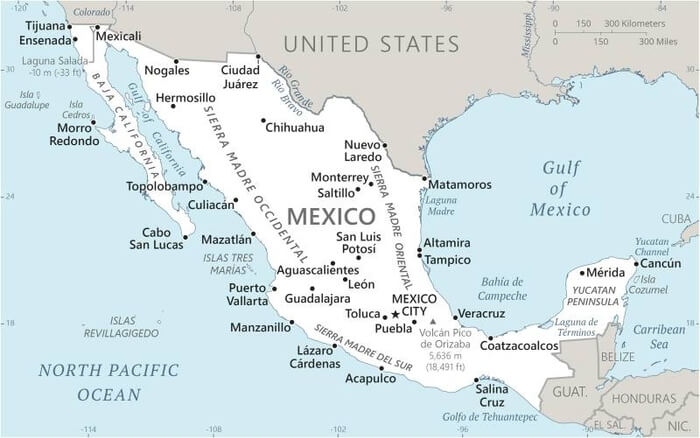
CIA map of Mexico
Administrative Divisions
Mexico is a federal republic composed of 31 states. Each state has its congress and constitution. States are further divided into municipalities. Residents elect a state governor every six years.
Capital City
- Mexico City "Ciudad de México" (CDMX): Mexico City has a special status known as "Ciudad de México," which grants it a level of autonomy similar to that of a state. This autonomy allows the city to have its own government and legislative assembly, separate from the federal government. The city is divided into 16 boroughs.
States
The 31 states of Mexico, their capital cities, and a brief description are as follows:
-
Aguascalientes (Capital: Aguascalientes): Located in central Mexico, Aguascalientes is known for its industrial development, particularly in the automotive sector. It is also known for its cultural festivals and historical sites.
-
Baja California (Capital: Mexicali): Baja California is in northwestern Mexico and shares a border with the United States. It is known for its coastal cities, including Tijuana and Ensenada, and its wine-producing region in the Valle de Guadalupe.
-
Baja California Sur (Capital: La Paz): Baja California Sur is the southern counterpart of Baja California. It is famous for its stunning beaches, marine life, and tourist destinations such as Cabo San Lucas and La Paz.
-
Campeche (Capital: San Francisco de Campeche): Located on the Yucatán Peninsula, Campeche is known for its rich Mayan history, archaeological sites, and well-preserved colonial architecture. It also has a significant oil industry.
-
Chiapas (Capital: Tuxtla Gutiérrez): Chiapas is in southern Mexico and is known for its indigenous culture, lush rainforests, and archaeological sites, including Palenque. It is one of Mexico's most culturally diverse states.
-
Chihuahua (Capital: Chihuahua): Chihuahua is Mexico's largest state known for its rugged landscapes, including the Sierra Madre mountains. The city of Chihuahua is the state's capital.
-
Coahuila (Capital: Saltillo): Coahuila is known for its historical significance, including its role in the Mexican Revolution. It is also a significant steel producer with a growing wine industry in Valle de Parras.
-
Colima (Capital: Colima): Colima is one of Mexico's smallest states and is located on the Pacific coast. It is known for its volcanoes, including the active Volcán de Colima, and its agricultural output.
-
Durango (Capital: Victoria de Durango): Durango is known for its natural beauty, including mountains, forests, and rivers. It has a rich mining history and is famous for the annual Feria Nacional Durango, a cultural festival.
-
Guanajuato (Capital: Guanajuato): Guanajuato is known for its colonial architecture, historic silver mines, and cultural events like the Cervantino Festival. It is also home to the city of León, known for its leather goods.
-
Guerrero (Capital: Chilpancingo de los Bravo): Guerrero is located on the Pacific coast and is known for its beautiful beaches, including Acapulco and Zihuatanejo. It is also culturally rich, with a strong indigenous presence.
-
Hidalgo (Capital: Pachuca de Soto): Hidalgo is known for its mining history, beautiful landscapes, and the historic mining town of Real del Monte. It is also famous for its cuisine, including pastes (savory pastries).
-
Jalisco (Capital: Guadalajara): Jalisco is one of Mexico's most iconic states, known for mariachi music, tequila production, and its vibrant culture. Guadalajara is the second-largest city in Mexico.
-
México (Capital: Toluca de Lerdo): The State of Mexico surrounds Mexico City and is known for its urbanization, industry, and cultural heritage. It is home to the archaeological site of Teotihuacán.
-
Michoacan (Capital: Morelia): Michoacán is known for its indigenous traditions, colonial cities, and natural beauty. It is famous for the Day of the Dead celebrations in places like Patzcuaro.
-
Morelos (Capital: Cuernavaca): Morelos is a small state known for its pleasant climate and historical significance. Cuernavaca is often called the "City of Eternal Spring."
-
Nayarit (Capital: Tepic): Nayarit is located on the Pacific coast and is known for its beautiful beaches, including those in the Riviera Nayarit. It offers a mix of natural beauty and cultural attractions.
-
Nuevo León (Capital: Monterrey): Nuevo León is an industrial hub known for its economic activity, education, and technology. Monterrey, the capital city, is a significant business center in Mexico.
-
Oaxaca (Capital: Oaxaca de Juárez): Oaxaca is known for its indigenous cultures, including the Zapotec and Mixtec civilizations. It is famous for its cuisine, art, and the city of Oaxaca.
-
Puebla (Capital: Puebla de Zaragoza): Puebla is known for its colonial architecture, including the historic center of Puebla City. It is famous for dishes like mole poblano and its pottery.
-
Querétaro (Capital: Santiago de Querétaro): Querétaro is known for its colonial architecture, including the historic center of Santiago de Querétaro. It is a growing industrial and technological hub.
-
Quintana Roo (Capital: Chetumal): Quintana Roo is a popular tourist destination known for its stunning beaches in Cancún, Playa del Carmen, and the Maya Riviera.
-
San Luis Potosí (Capital: San Luis Potosí): San Luis Potosí is known for its mining history, colonial architecture, and natural beauty. It is also an important industrial and commercial center.
-
Sinaloa (Capital: Culiacán Rosales): Sinaloa is known for its agriculture, including cultivating tomatoes and other crops. It has a significant presence in Mexico's music and entertainment industry.
-
Sonora (Capital: Hermosillo): Sonora is located in northwestern Mexico and is known for its desert landscapes and beautiful beaches along the Sea of Cortez. It has a strong ranching tradition.
-
Tabasco (Capital: Villahermosa): Tabasco is known for its tropical climate and lush rainforests. It is a crucial oil-producing region in Mexico.
-
Tamaulipas (Capital: Ciudad Victoria): Tamaulipas is located along the Gulf of Mexico and is known for its industry, commerce, and border city of Reynosa. It has beautiful Gulf Coast beaches.
-
Tlaxcala (Capital: Tlaxcala de Xicohténcatl): Tlaxcala is the smallest state in Mexico and is known for its rich cultural heritage, including traditional festivals and indigenous traditions.
-
Veracruz (Capital: Xalapa-Enríquez): Veracruz is known for its coastal cities, including Veracruz City and Boca del Río. It has a diverse cultural heritage and is famous for its music, dance, and cuisine.
-
Yucatán (Capital: Mérida): Yucatán is known for its Mayan heritage, archaeological sites like Chichen Itza, and beautiful colonial cities. Mérida is the cultural and economic center of the state.
-
Zacatecas (Capital: Zacatecas): Zacatecas, situated in north-central Mexico, is renowned for its colonial charm, preserved historic architecture, and rich mining heritage. Zacatecas City is a UNESCO World Heritage Site known for its ornate architecture. The city hosts vibrant cultural festivals throughout the year.
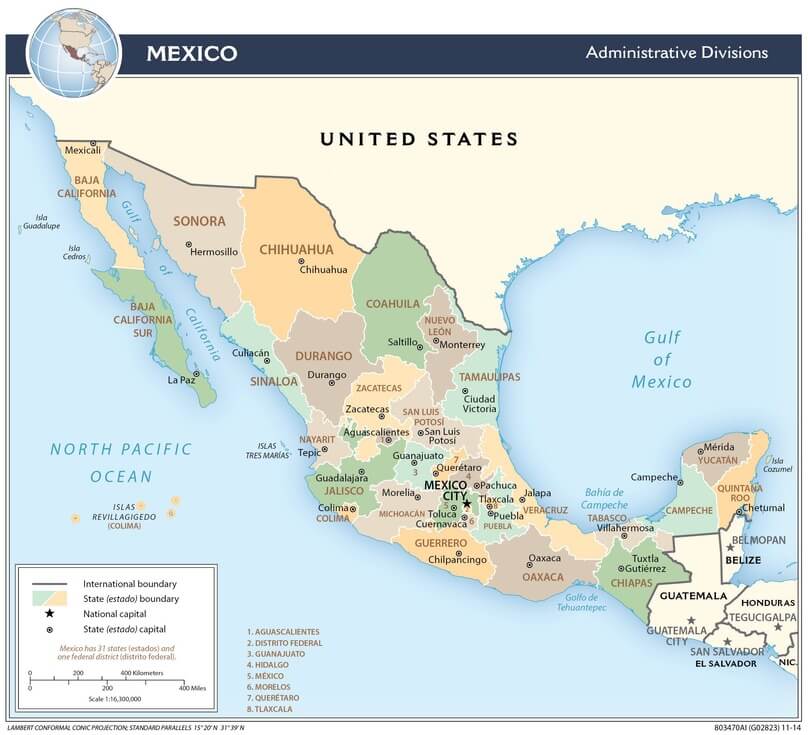
Mexico administrative map
Geographic Regions (Zones)
Mexico can be divided into nine major physiographic regions:
-
Baja California is an arid peninsula in northwestern Mexico.
-
Pacific Coastal Lowlands (Coastal Plain): a series of coastal terraces, mesas, and small basins interspersed with river deltas in western Mexico
-
Mexican Plateau: a largely arid and semiarid plateau that occupies much of northern and central Mexico
-
Sierra Madre Oriental: a range of folded mountains on the eastern side of the Mexican Plateau
-
Sierra Madre Occidental: runs parallel to the Pacific coast, through northwestern and western Mexico and along the Gulf of California
-
Trans-Mexican Volcanic Belt: the Sierra Nevada is located in south-central Mexico, extending east-west across the country from the Pacific Ocean to the Gulf of Mexico
-
Gulf Coastal Plain: characterized by lagoons and swamps, extends along the Gulf of Mexico from the Texas border to the Yucatán Peninsula.
-
Southern Highlands: include the Sierra Madre del Sur, Mesa del Sur, and the Sierra Madre de Chiapas along the Pacific coast in southern Mexico.
-
Yucatán Peninsula: the exposed portion of the more extensive Yucatán Platform and lies between the Gulf of Mexico and the Caribbean Sea
See more: Natural Landscape of Mexico
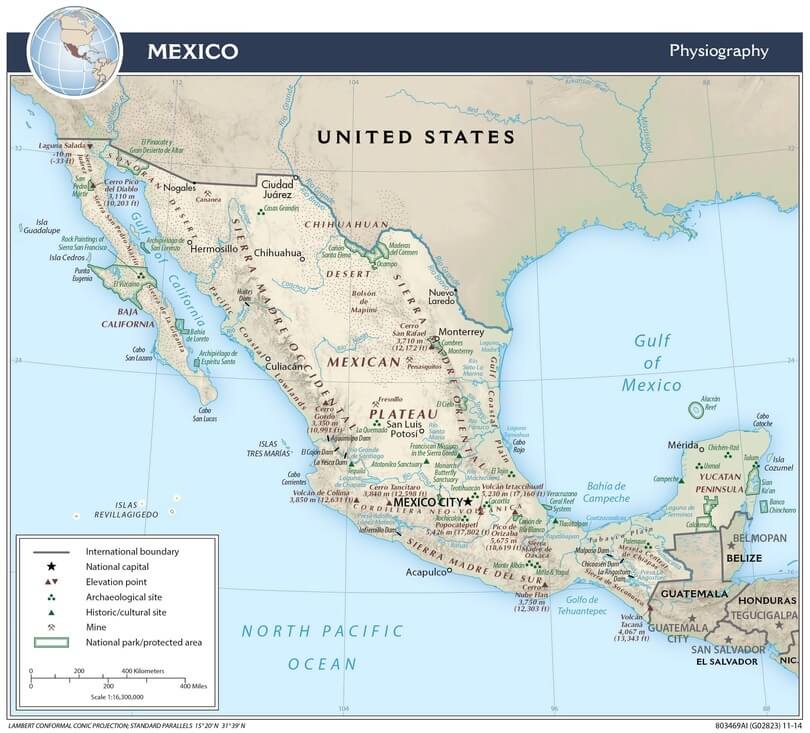
Mexico physiographic map
Historical, Cultural, and Natural Landmarks
Mexico is a vast and diverse country with many historical, cultural, and natural landmarks. Here are some notable examples, separated by region:
Baja California
The Baja California region of Mexico is a diverse and breathtaking destination known for its stunning landscapes, natural wonders, and rich cultural heritage. Here are some of the notable attractions, landmarks, and protected areas in the region:
-
El Arco de Cabo San Lucas: Also known as "The Arch," it is a distinctive rock formation at Land's End in Cabo San Lucas. This iconic landmark is a popular tourist spot and offers picturesque sea views.
-
La Bufadora: Located near Ensenada, La Bufadora is one of the largest blowholes in North America. This natural wonder shoots water into the air as high as 30 m (98 ft), creating a spectacular sight for visitors.
-
Sierra de San Pedro Mártir National Park: This national park is a haven for nature lovers and outdoor enthusiasts in the northern part of Baja California. It features diverse ecosystems, including pine and oak forests, picturesque mountains, and the highest peak in Baja California, Picacho del Diablo.
-
Valle de Guadalupe: Known as the wine country of Baja California, Valle de Guadalupe is a region famous for its vineyards and wineries. Visitors can enjoy wine tastings, explore scenic landscapes, and indulge in the local culinary delights.
-
Loreto Bay National Park: Located in the Sea of Cortez, Loreto Bay National Park is a marine protected area renowned for its vibrant marine life. It offers opportunities for snorkeling, diving, kayaking, and observing diverse species such as dolphins, whales, and sea lions.
-
Isla Espíritu Santo: Part of the Gulf of California Biosphere Reserve, this uninhabited island is a pristine natural paradise. It features secluded beaches, crystal-clear waters, rich biodiversity, and endemic plant species and marine life.
-
Cueva de la Virgen: Situated in San Ignacio, this impressive cave system is known for its ancient rock art and underground chambers. Visitors can explore the cave's intriguing formations and admire the well-preserved paintings that offer insights into the region's ancient cultures.
-
Todos Santos: A charming coastal town with a vibrant arts scene, Todos Santos is known for its colonial architecture, galleries, and craft shops. It also offers beautiful beaches and is a popular spot for surfing.
-
Cabo Pulmo National Marine Park: Located on the East Cape of Baja California, Cabo Pulmo is a protected area renowned for its vibrant coral reefs. It is home to many marine species and offers excellent opportunities for snorkeling and diving.
-
San Felipe: A popular beach resort town on the Sea of Cortez, San Felipe offers sandy beaches, water sports, and a lively atmosphere. It is known for its annual off-road racing events and is a gateway to the Gulf of California.
Pacific Coastal Lowlands (Coastal Plain)
The Pacific Coastal Lowlands, also known as the Coastal Plain, is a scenic region in Mexico that stretches along the country's Pacific coastline. Its beautiful beaches, lush vegetation, and diverse wildlife characterize it. Here are some of the notable attractions, landmarks, and protected areas in this region:
-
Puerto Vallarta: This famous resort city is known for its picturesque beaches, vibrant nightlife, and charming old town. Visitors can enjoy water sports, explore the lively Malecon boardwalk, and take boat trips to nearby attractions like Los Arcos National Marine Park.
-
Acapulco: A historic coastal city, Acapulco is famous for its stunning beaches, cliff divers at La Quebrada, and lively entertainment scene. It offers opportunities for water activities, cultural experiences, and vibrant nightlife.
-
Huatulco: Located in Oaxaca, Huatulco is a series of nine beautiful bays with pristine beaches and crystal-clear waters. The region is known for its eco-tourism initiatives, including protected areas and sustainable practices.
-
Mazatlán: Mazatlán is a vibrant coastal city with traditional and modern attractions. It boasts beautiful beaches, a charming historic center, and a lively boardwalk known as the Malecon. Mazatlán is also known for its cultural festivals and delicious seafood.
-
Marietas Islands: Situated off the coast of Nayarit, the Marietas Islands are a group of small uninhabited islands. They are a protected area and a UNESCO Biosphere Reserve, offering stunning natural beauty, hidden beaches like the famous "Hidden Beach," and diverse marine life.
-
Chamela-Cuixmala Biosphere Reserve: Located in Jalisco, this biosphere reserve protects diverse ecosystems, including mangroves, tropical forests, and coastal lagoons. It offers opportunities for birdwatching, hiking, and exploring the area's rich biodiversity.
-
Balandra Beach: Located near La Paz in Baja California Sur, Balandra Beach is a pristine and tranquil beach known for its turquoise waters and unique rock formations. It is a popular spot for swimming, kayaking, and enjoying the area's natural beauty.
-
La Tovara National Park: Situated near San Blas in Nayarit, La Tovara National Park is a protected area encompassing a network of freshwater canals, mangroves, and diverse wildlife. Visitors can take boat tours to explore the lush vegetation and spot birds, crocodiles, and other animals.
-
Manzanillo: This coastal city in Colima is known for its beautiful beaches, vibrant fishing port, and water sports opportunities. Manzanillo is also famous for its deep-sea fishing, attracting enthusiasts worldwide.
-
Isla Isabel: Located off the coast of Nayarit, Isla Isabel is a volcanic island and a protected national park. It is an important bird nesting site, including frigatebirds and blue-footed boobies. Visitors can enjoy birdwatching, snorkeling, and hiking on the island.
Mexican Plateau
The Mexican Plateau, also known as the Central Mexican Plateau, is a vast region in Mexico that encompasses highlands and plateaus located between the Sierra Madre Oriental and the Sierra Madre Occidental mountain ranges. This region is rich in cultural heritage, historical sites, and natural wonders. Here are some of the notable attractions, landmarks, and protected areas in the Mexican Plateau:
-
Mexico City: The capital city of Mexico, Mexico City is a vibrant metropolis with a rich history and cultural heritage. It is home to numerous landmarks, including the historic center with its Zócalo Square, the iconic Angel of Independence monument, and the ancient Aztec ruins of Templo Mayor. The city also offers world-class museums like the National Museum of Anthropology and a thriving arts and culinary scene.
-
Teotihuacan: Located just outside Mexico City, Teotihuacan is an ancient Mesoamerican city and UNESCO World Heritage site. It is famous for its monumental pyramids, including the Pyramid of the Sun and the Pyramid of the Moon. Visitors can explore the archaeological site, climb the pyramids, and learn about the fascinating history of the pre-Columbian civilizations that inhabited the area.
-
Guanajuato: A colonial city nestled in the mountains of central Mexico, Guanajuato is known for its colorful buildings, narrow cobblestone streets, and underground tunnels. It is a UNESCO World Heritage site and offers attractions such as the stunning Juarez Theater, the iconic Callejón del Beso (Alley of the Kiss), and the Museum of the Mummies.
-
San Miguel de Allende: Another UNESCO World Heritage site, San Miguel de Allende is a picturesque colonial town renowned for its well-preserved architecture and artistic ambiance. It features beautiful churches, charming plazas, and art galleries. The town is also known for its vibrant festivals and cultural events.
-
Xochimilco: Located in the southern part of Mexico City, Xochimilco is a historic area famous for its network of canals and floating gardens called chinampas. Visitors can take colorful trajinera boats and cruise along the canals while enjoying traditional music, food, and the festive atmosphere. Xochimilco is recognized as a UNESCO World Heritage site.
-
Sierra Gorda Biosphere Reserve: Situated in Queretaro, the Sierra Gorda Biosphere Reserve is a protected natural area renowned for its stunning landscapes and biodiversity. It encompasses diverse ecosystems, including forests, canyons, rivers, and waterfalls. The reserve offers opportunities for hiking, birdwatching, and exploring its natural wonders.
-
Real de Catorce: Nestled in the mountains of San Luis Potosi, Real de Catorce is a charming ghost town with a rich mining history. It is known for its well-preserved colonial architecture, narrow streets, and famous Parroquia de Guadalupe church. Visitors can also explore the surrounding desert landscapes and visit the Wirikuta Desert, a sacred site for the indigenous Huichol people.
-
Queretaro: The capital city of Queretaro, Queretaro is a UNESCO World Heritage site known for its well-preserved historic center. It features beautiful squares, colonial buildings, and the iconic Aqueduct of Queretaro. The city is also renowned for its vibrant food scene and local wine production.
-
Puebla: Located east of Mexico City, Puebla is a colonial city famous for its intricate Talavera pottery and exquisite cuisine. It is home to numerous historic buildings, including the stunning Puebla Cathedral and the ornate Rosary Chapel. Puebla is also known for its delicious mole poblano, a traditional Mexican dish.
-
Monarch Butterfly Biosphere Reserve: Located in the states of Michoacan and Mexico, this biosphere reserve is a critical habitat for migratory monarch butterflies. Millions of monarch butterflies travel thousands of miles to overwinter in the reserve's forests yearly. Visitors can witness this incredible natural phenomenon and explore the surrounding pine-oak forests.
Sierra Madre Oriental
The Sierra Madre Oriental is a vast mountain range in eastern Mexico, stretching from the northeastern states of Coahuila and Nuevo León down to the central state of Puebla. This region is characterized by its rugged landscapes, diverse ecosystems, and unique cultural heritage. Here are some of the notable attractions, landmarks, and protected areas in the Sierra Madre Oriental:
-
Cumbres de Monterrey National Park: Located in Nuevo León, this national park is a natural gem within the Sierra Madre Oriental. It offers breathtaking landscapes, including deep canyons, rugged peaks, and cascading waterfalls. The park is ideal for hiking, rock climbing, and wildlife observation.
-
Pico de Orizaba: Also known as Citlaltépetl, Pico de Orizaba is the highest peak in Mexico and the third highest in North America. Located on the border of Puebla and Veracruz, this stratovolcano attracts mountaineers and offers stunning views from its summit.
-
Sierra Gorda Biosphere Reserve: Extending across the states of Querétaro, Guanajuato, Hidalgo, and San Luis Potosí, the Sierra Gorda Biosphere Reserve is a protected area of exceptional biodiversity. It encompasses diverse ecosystems, including cloud forests, tropical rainforests, and canyons. Visitors can explore hiking trails, spot unique wildlife, and admire impressive waterfalls.
-
Basaltic Prisms of Santa María Regla: Located in Hidalgo, these basaltic formations are a natural wonder created by the cooling and solidification of lava flows. The towering prisms, reaching up to 40 m (131 ft) high, are awe-inspiring. Visitors can explore the area via walkways and bridges that offer stunning views of the cascading waterfalls and rock formations.
-
Real de Catorce: Situated in San Luis Potosí, Real de Catorce is a historic mining town in the Sierra Madre Oriental. Known for its well-preserved colonial architecture, narrow streets, and ancient churches, the city has a unique charm. Visitors can explore its picturesque streets, visit the stunning Parroquia de Guadalupe church, and experience the spiritual ambiance of Wirikuta, a sacred desert for the indigenous Huichol people.
-
Xilitla: Located in San Luis Potosí, Xilitla is famous for its surrealist garden, Las Pozas. British artist Edward James created the garden with whimsical sculptures, cascading waterfalls, and lush vegetation. It is a genuinely surreal and enchanting destination.
-
El Cielo Biosphere Reserve: Situated in Tamaulipas, El Cielo Biosphere Reserve is a protected area renowned for its rich biodiversity. It is home to diverse plant and animal species, including endangered and endemic species. The reserve offers opportunities for birdwatching, hiking, and exploring its unique cloud forest ecosystems.
Sierra Madre Occidental
The Sierra Madre Occidental is a majestic mountain range parallel to Mexico's western coastline, spanning several states, including Chihuahua, Durango, Sinaloa, and Nayarit. This region is known for its rugged beauty, diverse ecosystems, and rich cultural heritage. Here are some of the notable attractions, landmarks, and protected areas in the Sierra Madre Occidental:
-
Copper Canyon (Barrancas del Cobre): This vast canyon system in Chihuahua is often compared to the Grand Canyon in the United States. The Copper Canyon offers breathtaking views, deep gorges, and unique indigenous communities. The Chihuahua al Pacifico Railway (Chepe) provides a scenic journey through the canyons, allowing visitors to admire the spectacular landscapes.
-
Creel: Located in the heart of the Copper Canyon region, Creel is a charming town and a popular base for exploring the area. It offers opportunities for hiking, horseback riding, and visiting nearby waterfalls and traditional Rarámuri (Tarahumara) villages.
-
El Fuerte: Situated in Sinaloa, El Fuerte is a colonial town with a rich history. Its picturesque streets, colorful buildings, and well-preserved Spanish architecture create a charming ambiance. Visitors can explore the El Fuerte Museum, take a boat ride on the El Fuerte River, or learn about the region's indigenous cultures.
-
Basaseachi Falls: Located in Chihuahua, Basaseachi Falls is one of Mexico's tallest waterfalls. With a drop of over 800 feet, it offers a mesmerizing sight surrounded by lush vegetation. Visitors can hike to the viewpoint and admire the breathtaking cascade.
-
Sierra de Durango: This mountain range in Durango is part of the Sierra Madre Occidental and offers stunning landscapes and diverse ecosystems. The region is home to picturesque valleys, pine forests, and abundant wildlife. Visitors can explore the Sierra de Durango's natural beauty through hiking trails and camping.
-
Cusárare Falls: In Chihuahua, Cusárare Falls is a scenic waterfall in a lush canyon. The cascade drops about 100 feet into a beautiful pool below. The surrounding area is ideal for hiking and nature walks.
-
Huichol Route: The Sierra Madre Occidental region is significant for the indigenous Huichol (Wixárika) people. The Huichol Route provides a cultural and spiritual journey, allowing visitors to learn about Huichol traditions, artwork, and their connection to the natural world. The route includes sacred sites, traditional villages, and opportunities to witness Huichol ceremonies.
-
Sinaloa Nature Reserve: Located in Sinaloa, this protected area is known for its diverse flora and fauna. It encompasses rugged mountains, rivers, and tropical forests. The reserve offers opportunities for hiking, birdwatching, and wildlife observation.
Trans-Mexican Volcanic Belt
The Trans-Mexican Volcanic Belt is a prominent mountainous region extending across central Mexico, from the Pacific Coast to the Gulf of Mexico. A series of volcanic peaks and breathtaking landscapes characterize it. Here are some of the notable attractions, landmarks, and protected areas in the Trans-Mexican Volcanic Belt:
-
Popocatepetl and Iztaccihuatl: These two iconic volcanoes are located near Mexico City. Popocatepetl, or "Popo," is an active volcano and the second-highest peak in Mexico. Iztaccihuatl, or "Izta," is the third-highest volcano known for its snow-capped peaks resembling a sleeping woman. Visitors can hike or climb these volcanoes for stunning panoramic views.
-
Nevado de Toluca: In the State of Mexico, Nevado de Toluca is an extinct stratovolcano and the fourth-highest peak in Mexico. It offers beautiful crater lakes, hiking trails, and breathtaking scenery. The two main crater lakes, Laguna del Sol and Laguna de la Luna are popular attractions.
-
La Malinche National Park: Situated in the states of Tlaxcala and Puebla, this national park is named after the prominent volcano La Malinche, also known as Matlalcueye. The park features diverse ecosystems, including forests and alpine meadows. Visitors can hike to the summit of La Malinche for stunning views of the surrounding landscapes.
-
Puebla Cathedral: Located in the city of Puebla, the Puebla Cathedral is a prominent landmark and one of Mexico's finest examples of Spanish colonial architecture. The cathedral's grand façade, ornate interiors, and stunning altarpieces make it a must-visit attraction.
-
Cacahuamilpa Caves: Situated in Guerrero, the Cacahuamilpa Caves are a remarkable natural wonder. These vast limestone caves feature impressive stalactite and stalagmite formations, underground rivers, and spacious chambers. Guided tours allow visitors to explore the fascinating underground world.
-
Paricutin Volcano: Paricutin is a cinder cone volcano in Michoacan. It is unique because it formed within a farmer's cornfield in 1943 and became one of the world's youngest volcanoes. Today, visitors can witness the preserved remains of the volcano and learn about its volcanic activity.
-
Lagunas de Zempoala National Park: Located in the State of Mexico, this national park is characterized by its beautiful mountain landscapes, lakes, and forests. It offers hiking trails, picnic areas, and opportunities for birdwatching and nature appreciation.
-
Izta-Popo Zoquiapan National Park: This protected area spans the states of Mexico, Puebla, and Tlaxcala, encompassing both the Popocatepetl and Iztaccihuatl volcanoes. It protects diverse ecosystems, including forests, grasslands, and high-altitude habitats. Visitors can enjoy hiking, camping, and wildlife observation.
Gulf Coastal Plain
The Gulf Coastal Plain is an eastern Mexico region stretching along the Gulf of Mexico coastline. This diverse region is known for its beautiful beaches, historic sites, and rich biodiversity. Here are some of the notable attractions, landmarks, and protected areas in the Gulf Coastal Plain:
-
Tampico: Located in Tamaulipas, Tampico is a vibrant coastal city known for its picturesque waterfront, colonial architecture, and lively atmosphere. Visitors can enjoy the city's beautiful beaches, explore the historic center, and indulge in fresh seafood.
-
Veracruz: Veracruz is a historic port city in Veracruz, renowned for its colonial architecture, vibrant culture, and rich musical traditions. The city offers attractions such as the landmark Zocalo, the San Juan de Ulua fortress, and the Malecon boardwalk. Veracruz is also famous for its lively Carnaval celebrations.
-
El Tajín: Located near the city of Papantla in Veracruz, El Tajín is an ancient Mesoamerican archaeological site and a UNESCO World Heritage site. It was the capital of the Totonac civilization and features impressive pyramids, ball courts, and intricate stone carvings.
-
Los Tuxtlas Biosphere Reserve: In Veracruz, the Los Tuxtlas Biosphere Reserve is a protected area known for its lush rainforests, volcanic peaks, and diverse wildlife. It offers opportunities for hiking, birdwatching, and exploring the region's natural wonders, including Catemaco Lake.
-
Laguna Madre and Tamaulipas Coast: Along the Gulf of Mexico coast in Tamaulipas, there are pristine beaches, lagoons, and estuaries. The Laguna Madre is a shallow hypersaline lagoon famous for its rich biodiversity and is an essential habitat for migratory birds.
-
La Pesca: La Pesca is a fishing village on Tamaulipas's Gulf Coast. It offers tranquil beaches, excellent fishing opportunities, and a laid-back atmosphere. Visitors can enjoy water sports, explore nearby mangroves, or relax on the sandy shores.
-
Sian Ka'an Biosphere Reserve: Although primarily located in the Yucatan Peninsula, the southern part of the Sian Ka'an Biosphere Reserve extends into Quintana Roo along the Gulf Coastal Plain. It is a UNESCO World Heritage site and encompasses diverse ecosystems, including wetlands, forests, and marine habitats. The reserve is home to various wildlife, including jaguars, manatees, and sea turtles.
Southern Highlands
The Southern Highlands region of Mexico is a mountainous area in the country's southern part, known for its stunning landscapes, indigenous cultures, and historical sites. Here are some of the notable attractions, landmarks, and protected areas in the Southern Highlands:
-
Oaxaca City: The city of Oaxaca is the cultural and artistic hub of the region. Its historic center, a UNESCO World Heritage site, is adorned with colonial architecture, vibrant markets, and the impressive Santo Domingo de Guzman Church. Visitors can explore the city's rich indigenous heritage, visit museums, and enjoy traditional cuisine.
-
Monte Albán: Just outside Oaxaca City, Monte Albán is an ancient Zapotec archaeological site on a hilltop. It was one of the most important Mesoamerican cities and offers remarkable views of the surrounding valley. The site features impressive pyramids, temples, and intricate stone carvings.
-
Hierve el Agua: Located near Oaxaca City, Hierve el Agua is a natural wonder consisting of petrified waterfalls. These mineral formations resemble cascades and provide stunning panoramic views. Visitors can swim in the natural mineral pools and enjoy the unique beauty of the site.
-
Sumidero Canyon: In Chiapas, Sumidero Canyon is a breathtaking natural landmark. Carved by the Grijalva River, the canyon reaches impressive heights of over 1,000 m (3,300 ft). Visitors can take boat tours through the canyon to admire its towering cliffs, lush vegetation, and wildlife.
-
San Cristóbal de las Casas: This charming colonial town in Chiapas is renowned for its vibrant indigenous culture and stunning architecture. The town's historic center features well-preserved Spanish colonial buildings and colorful markets. Visitors can explore traditional villages, visit indigenous communities, and appreciate the local arts and crafts.
-
El Chiflón Waterfalls: Located near the town of Comitán in Chiapas, the El Chiflón Waterfalls are a series of cascades that create a spectacular natural landscape. The highest waterfall, Velo de Novia, drops about 120 meters (394 feet). Visitors can enjoy hiking trails, swim in natural pools, and marvel at the beauty of the waterfalls.
-
Lagunas de Montebello National Park: Situated in Chiapas near the border with Guatemala, this national park is renowned for its stunning lakes and diverse ecosystems. The park features more than 50 lakes of various sizes, each with its distinct color and beauty. Visitors can explore hiking trails, go boating, and enjoy picnics amidst the picturesque scenery.
-
La Encrucijada Biosphere Reserve: Located in Chiapas, La Encrucijada Biosphere Reserve is one of Mexico's most important mangrove ecosystems. It is home to various plant and animal species, including crocodiles, turtles, and migratory birds. Visitors can take boat tours to explore the mangroves and observe the abundant wildlife.
Yucatán Peninsula
The Yucatán Peninsula is a beautiful region in southeastern Mexico known for its stunning beaches, ancient Mayan ruins, and unique natural wonders. Here are some of the notable attractions, landmarks, and protected areas in the Yucatán Peninsula:
-
Chichén Itzá: This UNESCO World Heritage site is one of Mexico's most famous archaeological sites. Chichén Itzá was once a prominent Mayan city home to iconic structures such as the Temple of Kukulcan (El Castillo), the Great Ball Court, and the Sacred Cenote. Visitors can explore the ancient ruins and learn about the rich Mayan history and culture.
-
Tulum: Situated on the coast of the Yucatán Peninsula, Tulum is a unique archaeological site known for its well-preserved Mayan ruins overlooking the turquoise waters of the Caribbean Sea. The site features the iconic El Castillo pyramid and the Temple of the Descending God. Tulum also offers beautiful beaches, making it a popular destination for history enthusiasts and beach lovers.
-
Cenotes: The Yucatán Peninsula is renowned for its cenotes, natural sinkholes filled with crystal-clear groundwater. The ancient Mayans considered these cenotes sacred and offer swimming, snorkeling, and diving opportunities today. Some famous cenotes include Ik Kil, Dos Ojos, and Gran Cenote.
-
Sian Ka'an Biosphere Reserve: This UNESCO World Heritage site is a vast protected area that spans both land and sea. Sian Ka'an is home to diverse ecosystems, including tropical forests, mangroves, and coral reefs. Visitors can explore the reserve through guided tours, boat trips, and eco-friendly activities to observe its rich biodiversity.
-
Isla Mujeres: Located just off the coast of Cancun, Isla Mujeres is a charming island known for its pristine beaches and laid-back atmosphere. Visitors can enjoy snorkeling in the crystal-clear waters, exploring the island's colorful streets, and visiting attractions like the Punta Sur Eco-Park and the Underwater Museum of Art (MUSA).
-
Coba: Coba is an ancient Mayan city situated deep in the jungle of the Yucatán Peninsula. It is known for its impressive Nohoch Mul pyramid, the tallest in the region, and its network of ancient sacbe (stone causeways). Visitors can rent bicycles or hire a local guide to explore the archaeological site.
-
Xcaret: Xcaret is a nature park located near Playa del Carmen that offers a variety of attractions and activities. Visitors can enjoy snorkeling in underground rivers, swimming with dolphins, exploring Mayan ruins, and witnessing cultural performances that showcase Mexico's traditions and folklore.
-
Biosphere Reserves: The Yucatán Peninsula has several biosphere reserves protecting its unique ecosystems. In addition to Sian Ka'an, other notable reserves include the Ría Lagartos Biosphere Reserve in Yucatán and the Calakmul Biosphere Reserve in Campeche. These reserves offer opportunities for wildlife observation, birdwatching, and exploring untouched natural environments.
